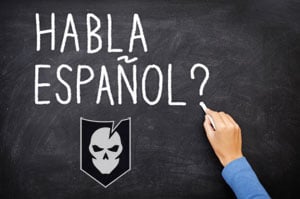A Guide to Practical Spanish Language as a Skill-Set – Lesson 2: Diving In
A Guide to Practical Spanish Language as a Skill-Set – Lesson 2: Diving In
Welcome to the second Practical Spanish lesson on ITS. In our first lesson, The Holy Grail, we focused on the proper pronunciation of the Spanish vowels and their placement. As stated in Lesson 1, this series is not meant to be your only resource, but rather a starting point, to be complemented by other resources such as media, available courses, or better yet, Spanish-speaking friends and acquaintances.
We encourage you to practice your Spanish skills whenever possible, as this will allow you to “tune your ear” to the language and allow you to pick it up faster. The instant feedback from native Spanish speakers reinforces the knowledge gained and minimizes future mistakes.
In this second Spanish lesson, we dive into the parts of speech. There are eight parts of speech in the Spanish language as well as in the English language: nouns, pronouns, adjectives, articles, verbs, adverbs, prepositions, conjunctions and interjections.
I. Nouns
A noun is the name of a person, place or thing. A proper noun is the name of a particular person, place or thing. Normally, names are not translated from one language to another, but over the years, some were adopted and changed to Spanish:
- Ricardo: Richard
- Enrique: Henry
- Juan: John
- Carlos: Charles
- Maria: Mary
- Juana: Jane
- Josefina: Josephine
- Nueva York: New York
- Nueva Jersey: New Jersey
- Nueva Orleans: New Orleans
- Londres: London
- Moscú: Moscow
- Japón: Japan
A common noun is a common name for persons, places or things:
- soldado: soldier
- marinero: sailor
- piloto: pilot
- policía: policeman
- bombero: fireman
- pueblo: town
- ciudad: city
- playa: beach
- carro: car
- camión: truck
In English there are three genders: masculine, feminine and neuter. In Spanish all nouns are either masculine or feminine. There is no neuter. Normally, nouns ending in “o” are masculine and nouns ending in “a” are feminine.
- el esposo: the husband
- la esposa: the wife
- las esposas: the handcuffs
- el perro: the dog
- la perra: the dog (female)
- la ciudad: the city
- el rifle (pronounced ree-fleh): the rifle
- la pistola: the pistol
- el carro: the car
- el camión: the truck
- la camioneta: the pickup truck
There are exceptions to the above:
- el policía: the policeman
- la policía: the police (force)
- los infantes de marina: the marines
- la mano: the hand
- el mapa: the map
- el día: the day
Nouns ending in a vowel form their plural by adding “s”, while those ending in a consonant form their plural by adding “es”. Nouns ending in a “z” change the “z” to a “c” before adding “es”.
The masculine plural of nouns and adjectives used as nouns may include both male and female when they denote rank or relation: “los niños” can mean the children, the boy and the girl, the boys and the girls, or the boys.
II. Pronouns
Pronouns are words that take the place of nouns, or are used instead of a noun. The Spanish subject nouns are:
Singular Pronouns
- 1st person singular: yo (I)
- 2nd person singular: usted (you, polite form)
- 2nd person singular: tú (you, familiar form)
- 3rd person singular: ella (she), él (he)
Plural Pronouns
- 1st person plural: nosotros (we)
- 2nd person plural: ustedes (used for both polite and familiar interactions)
- 3rd person plural: ellas (they, female), ellos (they, male or mixed crowd)
In the singular form, the polite form of you (usted) is always used for any person you’re not acquainted and familiar with. Although it is common for some people to go straight to the familiar form (tú), it is considered impolite by many, and insulting to older folks. It is recommended to stick to the polite form for encounters with older people, as it establishes a level of respect.
III. Adjectives
An adjective is a word that modifies a noun, either by limiting it or describing it:
- verde: green; rojo: red
- feo: ugly, male; fea: ugly, female
- alto: tall, male; alta: tall, female
- gordo: fat, male; gorda: fat, female
- viejo: old, male; vieja: old, female
- mucho: many, male; mucha: many, female
Adjectives agree in number and gender with the noun or pronoun they modify.
Adjectives form their plurals the same way as the nouns.
Adjectives ending in “o” in the masculine change the “o” to “a” to form the feminine. Other adjectives are the same for both genders. Exception: Adjectives of nationality ending in a consonant in the masculine singular add an “a” to form the feminine.
Singular:
- español: Spanish, male
- española: Spanish, female
- irlandes: Irish, male
- irlandesa: Irish, female
Plural:
- españoles: Spanish, male
- españolas: Spanish, female
- irlandeses: Irish, male
- irlandesas: Irish, female
Limiting adjectives precede the noun they modify:
- muchos rifles: many rifles
- nuestra casa: our house
- pocas cervezas: few beers
Descriptive adjectives generally follow the noun they modify:
- rifle negro: black rifle
- hombres feos: ugly men
- mujeres bonitas: beautiful women
IV. Articles
The articles in Spanish are adjectives. They precede the noun they modify in gender and number.
Singular form:
- Definite, masculine: el (the)
- Indefinite, masculine: un (a, an)
- Definite, feminine: la (the)
- Indefinite, feminine: una (a, an)
Plural form:
- Masculine: los (the)
- Feminine: las (the)
There are no plural indefinite articles.
Masculine nouns require a masculine article, and female nouns require a female article.
- el hombre (the man)
- la mujer (the woman)
- el carro (the car)
- la camioneta (the pickup truck)
- un rifle (a rifle)
- una pistola (a pistol)
Exception: Feminine nouns beginning with a stressed “a” or “ha” take the masculine article “el” in the singular form only. This does not change the gender of the noun.
- el agua (the water)
- las aguas (the waters)
- el hacha (the ax)
- las hachas (the axes)
When a noun is used in an abstract, general sense, it takes an article.
- El tiempo es oro. (Time is gold. – Spanish saying)
- El hombre es débil. (Man is weak.)
V. Verbs
A verb is a word that shows action, being, or state of being.
- Action: Eric lee un libro. (Eric reads a book)
- Being: Eric es un hombre. (Eric is a man)
- State of being: Eric está triste. (Eric is sad)
VI. Adverbs
An adverb is a word that modifies a verb by answering the following: where (place), how (manner) and when (time).
- temprano (early)
- tarde (late)
- cerca (near)
- lejos (far)
- aquí (here)
- allí (there)
- bien (well)
- más (more)
- nunca (never)
- muy (very)
- así (thus)
- entonces (then)
Ella dispara bien. (She shoots well.)
El es muy tonto. (He is very dumb.)
Esto es muy importante. (This is very important.)
Adverbs are often formed by adding “mente” to the feminine singular form of the adjective.
Adjective / Adverb
- triste (sad)
- tristemente (sadly)
- rápida (rapid)
- rápidamente (rapidly)
- feliz (happy)
- felizmente (happily)
- lenta (slow)
- lentamente (slowly)
- clara (clear)
- claramente (clearly)
- honesta (honest)
- honestamente (honestly)
When two or more adverbs occur in a series, only the last one take the “mente” The others assume the adverb form, but without the written “mente”.
Ella habla clara y honestamente. (She speaks clearly and honestly.)
Often, an adverbial phrase is used instead of an adverb.
Adverb / Adverbial phrase
- claramente (clearly)
- con claridad (clearly, with clarity)
- fácilmente (easily)
- con facilidad (easily)
- finalmente (finally)
- al fin, por fin (finally, at last)
VII. Prepositions
A preposition is a word that shows the relation of a noun or pronoun following it to another word in the sentence.
- de: of, from
- por: by, through, for
- en: on, in, at (location)
- para: for, in order to
- a: at (time), to
- con: with
- sobre: over, on
- sin: without
- desde: since, from
Prepositional pronouns are the same as the subject pronouns, except in the first and second person singular.
- mí: me
- ti: you, familiar form
When used after the preposition “con”, the first and second person singular change as follows:
- conmigo: with me
- contigo: with you
John está conmigo. (John is with me.)
¿Está John contigo? (Is John with you?)
The masculine singular definite article “el” contracts with the prepositions “a” and “de” respectively. Only the masculine singular definite article contracts in this manner. This does not apply the pronoun “él” (he).
- “a” plus “el”: al (to the)
- Yo voy al baño. (I’m going to the bathroom.)
- “de” plus “el”: del (from the , of the)
- Yo vengo del pueblo. (I come from the town.)
The word “casa” means “house”, when alone or accompanied by an article. When it is only accompanied by a preposition, it means “home”
- en la casa: at the house
- en casa: at home
- a la casa: to the house
- a casa: to home
- de la casa: from the house
- de casa: from home
In Spanish, a noun is never used as an adjective to show the material of which a thing is made. Instead, the object and material of which it is made are joined by the preposition “de”.
- Una camisa de seda. (A silk shirt.)
- Un anillo de oro. (A gold ring)
- Un bote de aluminio. (An aluminum boat.)
VIII. Conjunctions
A conjunction is a word used to join a word or group of word to a word or group of words.
- aunque (although)
- porque (because)
- o (or)
- si (if)
- pero (but)
- y (and)
IX. Interjections
An interjection is a word that expresses a strong or sudden feeling.
- ¡Qué triste! (How sad!)
- ¡No puede ser! (It can’t be!)
In the next installment, we will go into the Spanish sentence. As stated in the previous article, these lessons are just a base that needs to be expanded by actively practicing Spanish. There are many resources available and most schools, community colleges and universities offer Spanish classes with little or no prerequisites. Or you can practice with your Spanish-speaking friends or search YouTube for Spanish courses. Practice, practice, practice!
Author’s Note: For these lessons, I am using the material I presented as a Spanish Instructor at the U.S. Border Patrol Academy a decade ago. The lessons are based on the book “A Practical Spanish Grammar for Border Patrol Officers”, originally written by John G. Friar and George W. Kelly, and published by U.S. Department of Justice. The use of this book at the U.S. Border Patrol Academy has since been discontinued.
Editor-in-Chief’s Note: Jose has been a U.S. Border Patrol agent for 15 years and previously served for six years as a U.S. Army Infantryman. We’re looking forward to more of Jose’s expertise here on ITS. You can also check out the Border Book in the ITS Store, if you’re interested in a field guide that focuses on the Spanish you’ll need to know to protect yourself and teaches English speakers to clearly communicate with uneducated or educated Spanish speakers.












Discussion